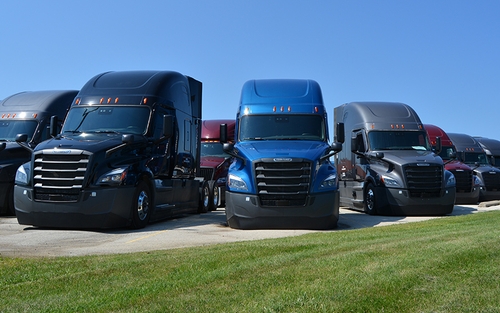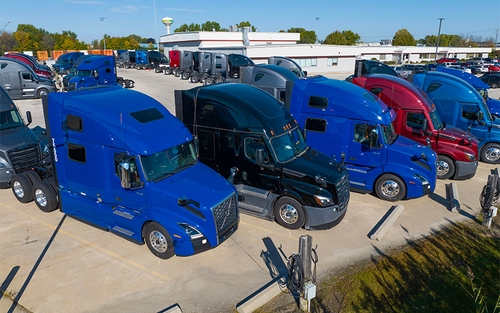How much do owner-operators spend on semi-truck maintenance costs?
September 30, 2025

Estimated reading time: 5 minutes
Generally, repair and maintenance costs for semi-trucks account for 10% of an owner-operator's total expenses. Understanding how to manage these costs can make a big difference to your overall profitability and long-term success.
To help maximize your business potential, we’ve outlined the average annual truck maintenance costs, along with key factors that influence these expenses and practical tips for keeping them under control.
Average semi-truck maintenance costs per year
According to a report by the American Transportation Research Institute:
- Truckload carriers with less than five trucks had average repair and maintenance costs of 16 cents per mile.
- Specialized carriers with less than five trucks had average repair and maintenance costs of 25 cents per mile
That means if you drive 100,000 miles in one year, your annual repair and maintenance costs could average between $16,000 and $25,000.
However, your maintenance costs could be less if you’re only operating one truck. American Truck Business Services (ATBS), for example, found its owner-operator clients had average repair and maintenance costs of 13 cents per mile.
5 factors that impact the average maintenance cost for a semi-truck
1. Preventive maintenance intervals.
As an owner-operator, preventative maintenance will likely be your most common maintenance expense. There are a few types of preventive maintenance visits you should know about:
Dry preventive maintenance
Dry preventative maintenance – known as a PM-A – usually includes services like a:
- Grease job.
- Fluid check.
- Tire pressure check.
- Component inspection (such as brakes, belts, lights or wipers).
Most manufacturers recommend scheduling a PM-A every 10,000 to 25,000 miles.
Cost of dry preventive maintenance
Prices vary by service center, but you can expect to spend around $100 on a PM-A.
Wet preventive maintenance
Wet preventative maintenance – or a PM-B – usually includes everything done in a PM-A, plus system inspections and an oil and filter change.
The average interval for a PM-B is about every 25,000 miles. However, many newer trucks can go up to 50,000 miles between oil changes with proper care.
Cost of wet preventive maintenance
Prices vary by service center, but Pilot Flying J centers, for example, charge about $300 for a full preventative maintenance service with conventional oil.
DOT truck inspections
Annual DOT inspections are required for all semi-trucks. The DOT-standard inspection takes about an hour and covers more than 50 vehicle components, including the:
- Brake system.
- Steering mechanism.
- Exhaust fuel systems.
- Windshield wipers.
- Cargo securement.
- Frame and suspension.
- Tires, wheels and rims.
- Lighting and turn signals.
Cost of DOT truck inspections
The price of getting a DOT inspection varies by location, but fees can run upwards of $200.
If you do business with a carrier they may, like Schneider, give you the option to get a full DOT-standard truck inspection every 90 days at no cost to you.
2. Unexpected repairs and breakdowns.
No amount of preventive maintenance can guarantee you won’t run into unexpected repairs or breakdowns.
Some of the most expensive unexpected truck repairs include:
- Engine overhaul (upwards of $10,000).
- Transmission replacement (upwards of $8,000).
- Brake system overhaul (upwards of $2,000).
- Suspension and steering system repairs (upwards of $1,000).
3. Tire replacements.
Service Tire Truck Centers reports the average semi-truck tire is priced between $250 and $600. Premium tires can cost upwards of $1,000. If all tires need to be replaced at the same time, expenses for an owner-operator can exceed $4,000.
Most experts agree that semi-truck tire replacement should occur every three to six years. This depends on mileage, driving conditions, tire type, etc.
4. Truck age and mileage.
Older trucks with a lot of miles are more prone to breakdowns than newer models, leading to more frequent repairs and downtime. Plus, an older unit may have outdated technology that can make finding replacement parts more challenging and require specialized repairs.
5. Driving conditions.
Extreme temperatures and rough terrain can cause more wear and tear on your truck.
Consistently operating in challenging environmental conditions may also require more frequent inspections to ensure the truck remains safe and reliable.
5 tips to manage semi-truck maintenance costs
Maintenance is a necessary part of running a trucking business. Luckily, there are things you can do to help manage your operating budget and keep maintenance expenses down.
1. Stay on top of preventative maintenance.
Preventative maintenance is key to avoiding more costly repairs and breakdowns. By catching small issues early, you can prevent them from turning into major problems that require expensive fixes and lead to significant downtime.
Follow your truck manufacturer’s recommended preventative maintenance intervals to ensure everything stays in good condition.
2. Create a maintenance fund.
A sudden breakdown can create significant financial stress if you’re not prepared. This is why creating a dedicated maintenance fund is an important part of owning a trucking business.
ATBS recommends setting aside between 7 and 15 cents per mile for general upkeep and repairs.
3. Invest in quality parts.
When it's time to replace a part, you might be tempted to choose the cheapest option. While it might save you money upfront, this approach can lead to higher costs in the long run due to faster wear and tear.
Investing in high-quality, durable parts from reputable manufacturers typically results in better performance and a longer service life. This will help you save money over time by reducing the frequency of replacements and minimizing the risk of related breakdowns.
4. Do business with a company that offers maintenance discounts.
Some motor carriers, like Schneider, have the buying power to help lower your business costs with discounts on maintenance, tires and more.
Owner-operators who do business with Schneider can also take advantage of lower-cost maintenance services offered at Schneider facilities.
5. Lease a newer truck from a reputable company.
Some truck leasing companies offer warranty coverage and maintenance assistance to help owner-operators manage the cost of repairs.
For example, SFI sends a portion of each customer's weekly truck payment to a maintenance account. Customers can use the money to pay for routine and unexpected truck maintenance. This helps prevent out-of-pocket expenses.
SFI’s maintenance program also includes:
- 24/7 maintenance support.
- Emergency roadside assistance.
- Discounts on labor and parts.
- Warranty recovery.
- Second opinions on repairs.



